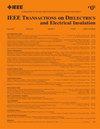Partial Discharge Aging of Epoxy Insulation at Different High-Frequency Pulse Parameters and Environmental Stresses
IF 3.1
3区 工程技术
Q2 ENGINEERING, ELECTRICAL & ELECTRONIC
IEEE Transactions on Dielectrics and Electrical Insulation
Pub Date : 2024-11-19
DOI:10.1109/TDEI.2024.3502581
引用次数: 0
Abstract
The voltage stress on high-frequency transformers (HFTs) features higher levels of repetition frequency, operating voltage, voltage dV/dt, and grid voltage superposition, which challenges the epoxy insulation of HFTs exposed to partial discharges (PDs). Wide ranges of voltage parameters (frequency, voltage, rising edge, and dc bias) and environmental stresses (temperature, humidity, gas, and pressure) are applied to the sphere-gap-insulation-plate structure for PD aging analysis. New patterns are found in this study. For example, the shape of the rising edge affects the lifetime, and the influences of humidity and dc bias are nonmonotonic. Surface charge decay and voltage dV/dt have key effects on the discharge pattern. Early failures with pulse frequencies of 50 and 100 kHz are attributed to the interaction of humidity and electric field. The erosion rate is lower at oxygen-free ambient, while higher with CO2 gas. PD parameters (PD number, PD amplitude, PD delay, PD ignition voltage, and PD frequency) and phase-resolved PD (PRPD) patterns are measured with the ultrahigh-frequency (UHF) method and discussed for all aging conditions. Cumulative PD amplitude and cumulative PD energy have a good correlation to experimental lifetime values. However, due to the transition of the PD regime, the fit model has less explainability on the influence of voltage, humidity, gas, and pressure on the lifetime, which is rarely revealed before.不同高频脉冲参数和环境应力下环氧绝缘局部放电老化研究
高频变压器(HFTs)的电压应力具有较高的重复频率、工作电压、电压dV/dt和电网电压叠加水平,这对局部放电(pd)下高频变压器的环氧绝缘提出了挑战。广泛的电压参数(频率、电压、上升沿和直流偏置)和环境应力(温度、湿度、气体和压力)应用于球隙绝缘板结构进行PD老化分析。在这项研究中发现了新的模式。例如,上升沿的形状影响寿命,湿度和直流偏置的影响是非单调的。表面电荷衰减和电压dV/dt对放电模式有关键影响。脉冲频率为50 kHz和100 kHz的早期失效是由于湿度和电场的相互作用造成的。在无氧环境下,侵蚀速率较低,而在CO2环境下,侵蚀速率较高。用超高频(UHF)方法测量了PD参数(PD数、PD幅值、PD延迟、PD点火电压和PD频率)和相位分辨PD (PRPD)模式,并讨论了所有老化条件下的PRPD模式。累积放电振幅和累积放电能量与实验寿命值有良好的相关性。然而,由于PD状态的转变,拟合模型对电压、湿度、气体和压力对寿命的影响的可解释性较低,这在以前很少被揭示。
本文章由计算机程序翻译,如有差异,请以英文原文为准。
求助全文
约1分钟内获得全文
求助全文
来源期刊
CiteScore
6.00
自引率
22.60%
发文量
309
审稿时长
5.2 months
期刊介绍:
Topics that are concerned with dielectric phenomena and measurements, with development and characterization of gaseous, vacuum, liquid and solid electrical insulating materials and systems; and with utilization of these materials in circuits and systems under condition of use.

 求助内容:
求助内容: 应助结果提醒方式:
应助结果提醒方式:


